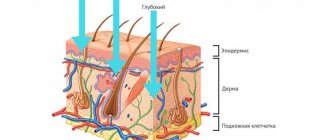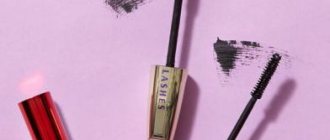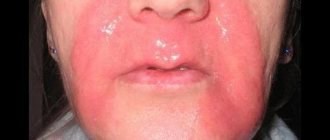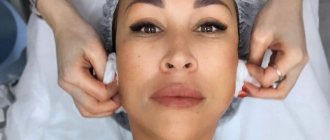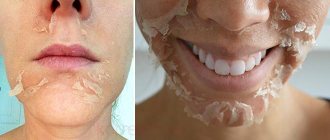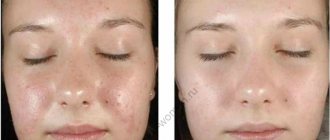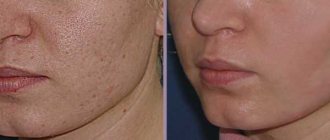The condition of the face in the first days after acid exfoliation often frightens patients: especially those who decide to undergo such cleansing for the first time. The main reasons for fear are “I burned my skin” and “this will never go away.” What to do if a burn appears after peeling? Which fears are justified and which are not?
NORMAL OR SIDE EFFECT
Any chemical exfoliation is effective, essentially, because of the burn.
Exfoliants contain various acids that act, depending on the type of cleaning, on the upper or middle layers of the skin.
In the process of exposure to reagents, tissues are renewed: keratinized cells are exfoliated, blood microcirculation improves, and the synthesis of collagen and elastin is accelerated.
These goals can only be achieved by using the correct concentration of acids and following cleaning techniques.
If the exfoliant is too aggressive or is left on the skin for longer than necessary , the chemical burn will move from the category of normal phenomena to the category of medical problems.
Only a slight first-degree burn provides a positive cleaning effect. More severe forms can cause significant harm.
Normal effects of cleaning with acids:
- Peeling that goes away after a few days;
- Mild swelling;
- Itching.
That is, the feeling of tightness, as well as itching and tingling associated with peeling, is not a cause for concern.
If after peeling there is a strong burning sensation, blisters have formed, and any touch to the face is painful, we are talking about a more serious chemical burn.
Abnormal consequences:
- Infections;
- Pigmentation;
- Scars.
Risk of severe chemical damage
Experts distinguish 4 degrees of burns , which are characterized by various tissue damage:
- A first-degree burn involves redness and mild swelling: such a reaction after a chemical peel is considered normal.
- The second degree is characterized by the appearance of blisters filled with a yellowish liquid: over time they burst.
- In the third degree, the skin dies and scabs form.
- In the fourth degree , both the dermis and muscle tissue are affected, and in complex cases, even the bones.
With chemical peeling there is a risk of any degree of damage. Therefore, acids should be treated with caution.
Mistakes when cleaning at home are fraught with consequences, including serious injury. That is why it is better to carry out the procedure with a specialist.
How to avoid erosions
First of all, it is necessary to clearly collect the client’s medical history with detailed clarification and exclusion of the use a few days before the procedure of a number of products containing: azelaic acid, benzoyl peroxide, AHA and BHA in a high percentage, etc.
During the procedure itself, it is important not to be distracted and not to leave the client with the peeling composition applied to the skin, but to control how the skin behaves during the exposure period and perform neutralization, even early, if necessary.
Which peeling to choose for sensitive skin with broken barriers and increased sensitivity, read the article at the link .
WHAT TO DO TO SPEED UP HEALING
To speed up the healing process of a facial burn after peeling, in addition to standard care, you can use a number of medications:
- antihistamines, which should be prescribed by a doctor,
- medicinal ointments,
- creams and various masks.
When choosing medicinal and cosmetic products, you need to carefully study their composition.
Preference should be given to those that provide hydration, promote regeneration, and have a calming and antibacterial effect.
To speed up recovery, you need to follow a number of general rules :
Also on topic : FACE AFTER PEELING: 6 questions for a cosmetologist
How long do burns last?
The speed at which the epidermis recovers after exfoliation depends on the type of cleansing:
- If we are talking about superficial effects , the epidermis is restored in a matter of days.
- Exfoliation after a midline chemical peel requires more time for regeneration from the burn. Peeling can last from 1-2 days to a week, but its completion does not mean that the tissues have completely recovered. This process usually takes 2-4 weeks.
Serious injuries associated with violation of the rules of the procedure must be treated under medical supervision.
Restoration of the dermis can take from several weeks to months.
Contraindications to deep peeling
Deep skin peeling is not recommended for people with dark skin. A chemical burn leads to disruption of the production of melanin pigment in the affected area, as a result of which the renewed and rejuvenated skin will be noticeably paler than in other parts of the body. This will reduce the aesthetic value of the anti-aging procedure.
Deep peeling is contraindicated for persons with inflammatory reactions on the skin of autoimmune, allergic or infectious origin, diseases of the hepatobiliary system and kidneys, oncopathology, diabetes mellitus. Phenolic peeling is not performed during pregnancy and lactation. Individual intolerance to the drug and allergies are also contraindications for the procedure.
PRECAUTIONARY MEASURES
Exfoliation acids are serious allergens . It is worth finding out in advance whether there is a possibility of side effects due to a reaction to the components of the exfoliant
Ignoring precautions can significantly aggravate the situation with facial burns after peeling: allergies lead to swelling, redness, itching and rashes. You will have to fight them with the help of antihistamines, and the healing process will be delayed.
You also need to prevent allergies to cosmetic and medicinal post-procedure care products. The body's reaction to such creams and ointments is also checked by testing on the bend of the elbow.
Why is a severe burn dangerous?
A first-degree burn that occurs after peeling is manifested by severe redness, swelling, peeling and dry skin. This is a normal reaction, the absence of which will indicate poor quality of the procedure and, most likely, no noticeable effect will be observed after peeling.
A severe second-degree burn is manifested, in addition to redness and peeling, by severe pain in the treated area, the formation of blisters, and cracking of the skin. Deep damage to the skin can lead to various complications, including:
- secondary infection of damaged tissues (bacteria easily penetrate into open wounds);
- the appearance of persistent pigment spots, which are very difficult to get rid of (damaged skin is sensitive to ultraviolet radiation, and even short-term exposure to bright sun without protective cream can cause pigmentation);
- formation of scars (scars formed in places of deep cracks are very difficult to correct and can only be eliminated by laser resurfacing).
EXTERNAL MEDICATIONS FOR BURNS AFTER PEELING
It is better to find out how to treat burns at a consultation with a dermatologist: there are many drugs on the market that are positioned as ointments for treating burns.
The following pharmaceutical anti-inflammatory drugs have proven their effectiveness :
Panthenol
Products based on dexpanthenol stimulate regeneration and also increase the density of collagen fibers. The most popular trade name of the drug is Panthenol. The cream is applied up to 4 times a day.
Elokom
Medicines containing mometasone provide an anti-inflammatory effect and relieve itching. These include Elokom, which is presented in the form of cream, ointment and lotion. Apply a thin layer to the affected areas once a day.
FOLK RECIPES FOR BURNS
The burn after peeling will go away faster if the treatment is comprehensive. In addition to using the right cosmeceuticals, you can resort to traditional methods to speed up the process.
Vegetable mask
Grind half a fresh cucumber and 1 medium potato, finely chop a couple of sprigs of parsley. Mix the ingredients, add a teaspoon each of aloe and lemon juice, as well as a tablespoon of olive oil. Apply the mixture for 15 minutes and then rinse thoroughly with warm water. You can repeat the procedure twice a week.
Oatmeal decoction
A thick decoction is prepared from half a glass of oatmeal. Then two tablespoons of potato starch are added to them. Apply the finished mixture for 15 minutes. You can repeat the procedure every 2 days - the decoction softens the skin and speeds up the exfoliation process.
HOW TO TREAT A BURN FROM DIFFERENT PEELINGS
Methods for restoring the epidermis are generally similar. To prevent mistakes, you need to consider what exactly should be included in exfoliants.
Glycolic
Glycolic acid is one of the most gentle, so its concentration in cosmetic products ranges from 40 to 80%. Exceeding this norm is fraught with serious burns, but applying several layers of the reagent is acceptable. In this case, the entire procedure, together with pre-peeling preparation and acid neutralization, should take 20 minutes.
Salicylic
Salicylic acid is more aggressive, so its concentration can reach a maximum of 20-25%. A solution of 15% is also used - it is suitable for surface cleaning. Exposure time is maximum 20 minutes. This acid is incompatible with zinc oxide and resorcinol, so before and after the procedure you should avoid medications containing these ingredients.
Coral
Coral and other types of mechanical exfoliation by themselves do not lead to burns, only the symptoms are similar. However, mechanical damage to the epidermis is treated with the same anti-burn external medications.
In topic : 50 SHADES OF RED | What to do if your face is RED after peeling?
Question answer
What can lead to overexposure of the cleansing composition on the face?
Overexposure of the mixture to the skin leads to burns of varying severity. Then, to restore the skin, you should be examined by a doctor who will prescribe a course of treatment.
For minor damage, it is enough to use a vegetable mask and treat your face with Elok ointment.
How to reduce the risk of burns?
After any chemical peel, a first-degree burn occurs. To quickly get rid of side effects after peeling, it is recommended to smear the skin with Bepanten or Panthenol, try not to go outside during solar activity and remove the crusts yourself.
TREATING THE CONSEQUENCES OF BURN FROM PEELING
To prevent complications, the cosmetologist must carefully examine the condition of the skin in advance, select the correct acid concentration and mechanical cleaning technique.
Swelling from a burn after peeling
Swelling often occurs after exfoliation with trichloroacetic acid (TCA) and mechanical cleansing. This is due to the aggressive effect on the blood vessels adjacent to the surface.
Such swelling appears gradually - sometimes it appears only on the third day after the procedure. Preparations based on Depanthenol help in the fight against them.
Causes of burns
During chemical peeling, under the influence of acids, the stratum corneum of the skin is destroyed, and along with it, the active substance also affects the healthy epidermis, which leads to a burn.
A complication in the form of a burn above the first degree after any chemical peel appears due to:
- overexposure of the active substance beyond the recommended time;
- hypersensitive skin;
- allergic reaction to the ingredients of the composition;
- the presence of open wounds on the skin;
- using acid concentrations greater than 30%.
Often the reason for getting a severe burn is the unprofessionalism of the cosmetologist, who incorrectly assesses the initial state of the dermis, and, as a result, makes the peeling with an inappropriate composition.


